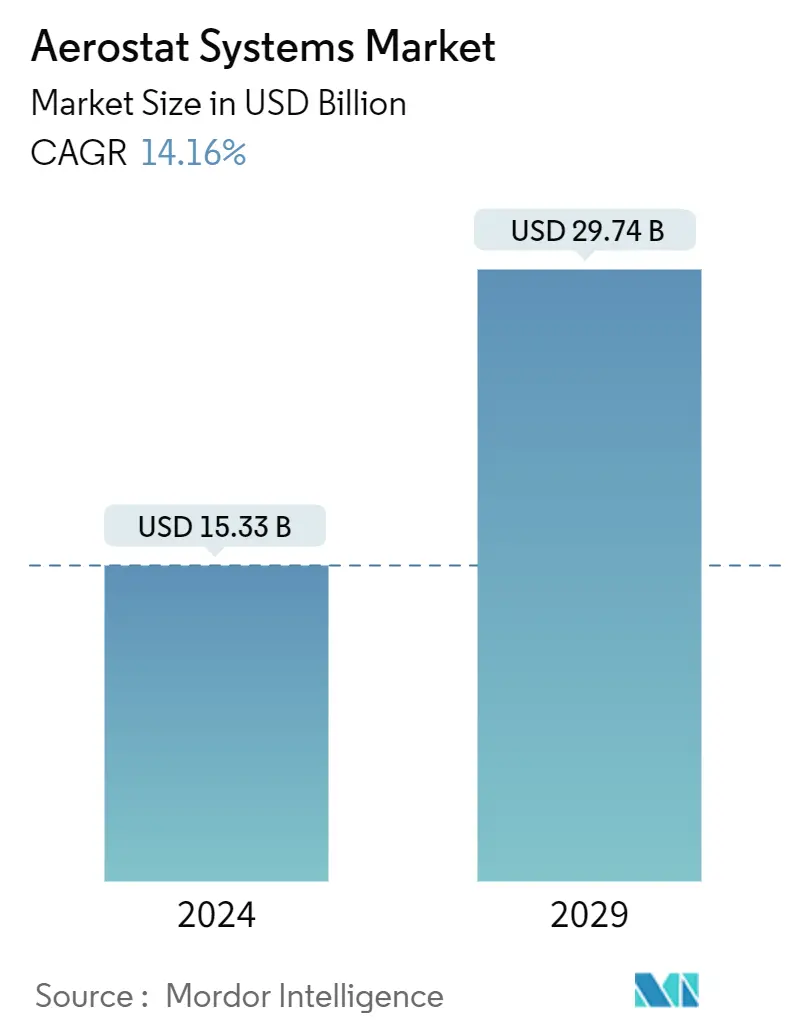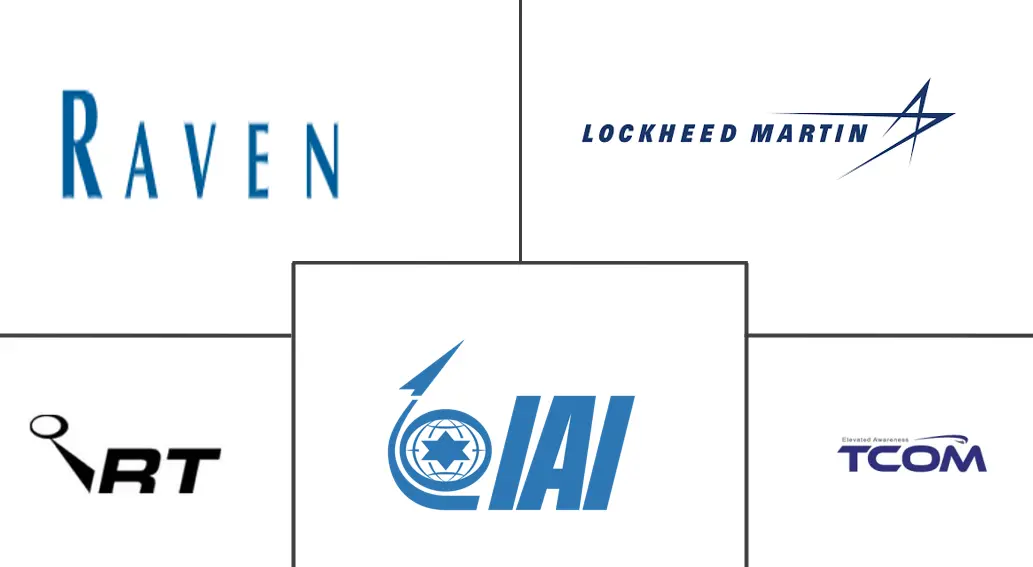Market Size of Aerostat Systems Industry

| Study Period | 2019 - 2029 |
| Market Size (2024) | USD 15.33 Billion |
| Market Size (2029) | USD 29.74 Billion |
| CAGR (2024 - 2029) | 14.16 % |
| Fastest Growing Market | North America |
| Largest Market | North America |
Major Players
*Disclaimer: Major Players sorted in no particular order |
Aerostat Systems Market Analysis
The Aerostat Systems Market size is estimated at USD 15.33 billion in 2024, and is expected to reach USD 29.74 billion by 2029, growing at a CAGR of 14.16% during the forecast period (2024-2029).
Factors like growing terrorism, increasing territorial tensions, and border infiltrations globally are propelling the militaries to enhance their battlefield data-sharing capabilities. Though UAVs are becoming popular for ISR missions, UAVs cannot offer continuous wide-area surveillance for several days, resulting in several countries adopting aerostats as an alternative. Aerostat systems may operate 24/7 for weeks or even months at a time, offering persistent surveillance.
Other than military applications, aerostats are becoming popular for environmental research and commercial applications, like internet connectivity. Aerostats are being used to expand LTE networks and 5G technology in remote areas at a significantly low cost and energy.
However, the aerostat systems market faces challenges and limitations for operational altitude and survivability in adverse weather conditions. These limitations are expected to challenge the market's growth during the forecast period.
Rapid technological advancements are driving the growth of the aerostat system industry. Innovations in sensor technology, communication systems, and materials enhance the capabilities and performance of aerostat systems, making them more efficient and adaptable for applications such as surveillance, reconnaissance, and communication.
Aerostat Systems Industry Segmentation
Aerostats are lighter than air aircraft that gain lift using buoyant gas. Aerostats may be free-flying or tethered.
The aerostat systems market is segmented by application and geography. By application, the market is segmented into military and law enforcement, and commercial and research. The report also covers the market sizes and forecasts for the aerostat systems market in major countries across different regions.
For each segment, the market size is provided in terms of value (USD).
| By Application | |
| Military and Law Enforcement | |
| Commercial and Research |
| By Geography | |||||||
| |||||||
| |||||||
| |||||||
| |||||||
|
Aerostat Systems Market Size Summary
The aerostat systems market is poised for significant growth, driven by increasing global security concerns such as terrorism and territorial tensions, which necessitate enhanced surveillance capabilities. Unlike UAVs, aerostats offer the advantage of continuous, wide-area surveillance for extended periods, making them a preferred choice for military applications. The market is also witnessing a surge in demand for aerostats in commercial sectors, particularly for expanding telecommunications networks like LTE and 5G in remote areas cost-effectively. Despite these growth drivers, the market faces challenges related to operational altitude and weather-related survivability, which could impact its expansion during the forecast period. Technological advancements in sensor and communication systems are further enhancing the capabilities of aerostat systems, making them more efficient for various applications, including surveillance, reconnaissance, and communication.
The military and law enforcement sectors dominate the aerostat systems market, with a significant share attributed to the demand for intelligence, surveillance, and reconnaissance support. Aerostats are increasingly being integrated into military operations for border surveillance and threat detection, as seen in recent deployments by the US and Israeli defense forces. In the commercial sector, collaborations between aerostat manufacturers and telecommunications providers are enhancing network quality and expanding market reach. The market is semi-consolidated, with major players like Lockheed Martin, TCOM, and Raven Industries leading the industry. Innovations such as AI-enabled platforms and unmanned aerostats are expected to shape the future of the market, offering enhanced capabilities and potential for new contracts. The integration of advanced sensors and technologies is anticipated to drive further growth, with manufacturers focusing on expanding their geographical footprint and increasing sales through strategic partnerships.
Aerostat Systems Market Size - Table of Contents
-
1. MARKET DYNAMICS
-
1.1 Market Overview
-
1.2 Market Drivers
-
1.3 Market Restraints
-
1.4 Porter's Five Forces Analysis
-
1.4.1 Bargaining Power of Suppliers
-
1.4.2 Bargaining Power of Buyers
-
1.4.3 Threat of New Entrants
-
1.4.4 Threat of Substitute Products
-
1.4.5 Intensity of Competitive Rivalry
-
-
-
2. MARKET SEGMENTATION
-
2.1 By Application
-
2.1.1 Military and Law Enforcement
-
2.1.2 Commercial and Research
-
-
2.2 By Geography
-
2.2.1 North America
-
2.2.1.1 United States
-
2.2.1.2 Canada
-
-
2.2.2 Europe
-
2.2.2.1 United Kingdom
-
2.2.2.2 France
-
2.2.2.3 Germany
-
2.2.2.4 Russia
-
2.2.2.5 Rest of Europe
-
-
2.2.3 Asia-Pacific
-
2.2.3.1 China
-
2.2.3.2 India
-
2.2.3.3 Japan
-
2.2.3.4 South Korea
-
2.2.3.5 Rest of Asia-Pacific
-
-
2.2.4 Latin America
-
2.2.4.1 Brazil
-
2.2.4.2 Mexico
-
2.2.4.3 Rest of Latin America
-
-
2.2.5 Middle-East and Africa
-
2.2.5.1 Saudi Arabia
-
2.2.5.2 United Arab Emirates
-
2.2.5.3 Egypt
-
2.2.5.4 Rest of Middle-East and Africa
-
-
-
Aerostat Systems Market Size FAQs
How big is the Aerostat Systems Market?
The Aerostat Systems Market size is expected to reach USD 15.33 billion in 2024 and grow at a CAGR of 14.16% to reach USD 29.74 billion by 2029.
What is the current Aerostat Systems Market size?
In 2024, the Aerostat Systems Market size is expected to reach USD 15.33 billion.

